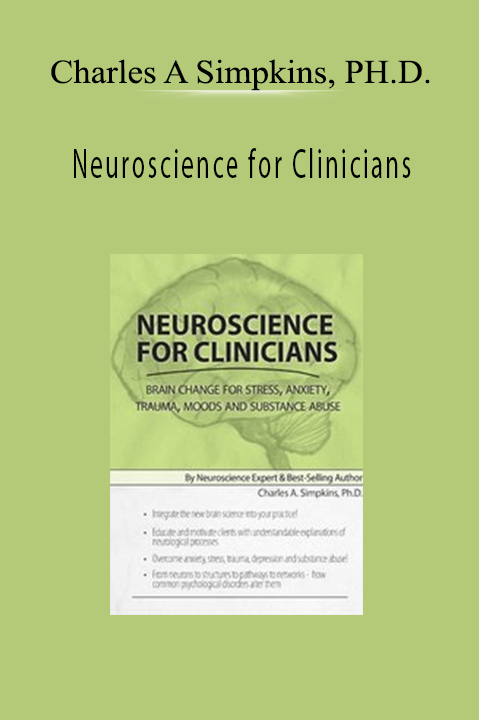-

Charles A Simpkins – Neuroscience for Clinicians: Brain Change for Stress, Anxiety, Trauma, Moods and Substance Abuse
Description
Neuroscience has given us incredible insights into the workings of the brain and its connection to our mental health. And recent research reveals that neuroplasticity takes place all through life, so you can offer hope for real change no matter how long your client has suffered.
This recording will connect complicated science with your clinical practice, and transform how you view and work with traumatized, stressed, addicted, anxious, and depressed clients!
Discover how and where neuroplasticity occurs, and ways to use it therapeutically. Participate in enjoyable learning experiences that provide you with the clear principles and background you need for utilizing neuroscience in your work. Draw on multiple modalities to overcome resistances, activate creative responses, and turn problems into potentials. Add new dimensions to each therapy session and initiate change using top-down, bottom-up, and horizontal methods that can be creatively individualized.
Leave this program as the most informed clinician you can be, and feel confident in bringing the latest findings from neuroscience into your treatments!
Handouts
| Manual (27.58 MB) | 116 Pages | Available after Purchase |
Outline
- Tour through the Brain: What clinicians need to know from neurons to structures, to pathways, to networks
- See brain structures in 3-D
- How the brain processes top-down, bottom-up, and horizontal
- The interplay of mental health and key nervous system structures, functions, and pathways
- Work with implicit and explicit memories
- How key pathways inform clinical interventions:
- Pain Pathway
- Reward Pathway
- Fear-Stress Pathway
- Nervous System Networks and the Social Brain: We are wired for attunement
- Default Mode (DMN) and Task Mode Networks (TMN)
- Healing attachment
- Activate mirror neurons bottom-up
- Neuroplasticity and Neurogenesis: How the brain can change
- Three timeframes for change
- Neuroplasticity at the synapse
- How to foster neuroplasticity in clients
- Neuroplasticity in action: Exercise your brain!
- Practice Interventions for Healing: Bottom-up, top-down, and horizontal
- Sensory Awareness
- Meditation and Mindfulness
- Body Work
- Unconscious and the DMN
- The Mind-Body Link
- Integrate the Brain into Treatments
- Stress
- How stress alters the nervous system
- Calm the stress/fear pathway
- Develop alert/relaxed attention for better coping
- Trauma
- Foster confidence with yoga
- Malleability of memories and clinical implications for treating trauma
- Reconsolidate implicit memories
- Anxiety
- The anxious brain reaction
- Work top down/ bottom up/ horizontally
- Calm the limbic system bottom up with movement
- Soothe the insula through meditative sensory awareness
- Deconstruct sensations mindfully
- Substance Abuse
- Brain areas involved in addictions
- Rewire the reward pathway
- Detach from pleasure and pain
- Prefrontal connections and judgment
- Depression
- The depressed brain pattern
- Effects of yoga and meditation on the nervous system
- Regulate the limbic system: the prefrontal cortex, cingulate gyrus and mindfulness
- Unify real and ideal
- Foster joyful relationship through mirror neurons
- Develop compassion and gratitude
- Stress
- 6 Principles for Incorporating the Brain into your Therapy
Faculty
Charles A Simpkins PH.D. Related seminars and products: 4
Charles A. Simpkins, Ph.D., is a psychologist specializing in neuroscience, psychotherapy, meditation and hypnosis. With his wife, Annellen, Charles has co-authored 28 books, many of them bestsellers. Their most recent books on neuroscience are Yoga and Mindfulness Therapy Workbook for Clinicians and Clients (PESI, 2014), Neuroscience for Clinicians (Springer, 2012), The Dao of Neuroscience (Norton 2010) and Neuro-Hypnosis (Norton 2010). They have also written about meditation for healthy mind-brain change: The Tao of Bipolar, (New Harbinger 2013), Zen Meditation in Psychotherapy (Wiley, 2012), Meditation and Yoga in Psychotherapy (Wiley, 2011), and Meditation for Therapists and Their Clients (Norton 2001). Their books have over 20 foreign editions and have won numerous awards.
Dr. Simpkins has practiced psychotherapy for more than three decades, and taught meditative and hypnotic methods to facilitate mind-brain change to people of all ages. He has been involved in neuroscience for 18 years – integrating it into treatments and helping to bring the most recent research findings to practitioners. He presents seminars at professional conferences, state mental hospitals, university campuses and to popular and professional audiences around the world. Charles performed psychotherapy research and is currently doing a neuroscience study of unconscious movement. He has studied with psychotherapy masters, including Milton H. Erickson, Jerome D. Frank, Carl Rogers, Lawrence Kubie, and Ernest L. Rossi, and neuroscience innovators including Vilayanur Ramachandran, Jaime Pineda, Paul and Patricia Churchland, Stephen Anagnostaras, and William Bechtel.
Instant Access Available
Product Content

Get Instant Access Charles A Simpkins – Neuroscience for Clinicians: Brain Change for Stress, Anxiety, Trauma, Moods and Substance Abuse at Offimc.click Now!
Delivery Information
- Upon ordering the product, a delivery email with download instructions will be sent immediately to you so that you may download your files. If you log in (or create an account) prior to purchase you will also be able to access your downloads from your account dashboard.
- It is a digital download, so please download the order items and save them to your hard drive. In case the link is broken for any reason, please contact us and we will resend the new download link to you.
- If you don't receive the download link, please don’t worry about that. We will update and notify you as soon as possible from 8:00 AM – 8:00 PM (UTC+8).
- Please Contact Us if there are any further questions or concerns you may have. We are always happy to assist!








10 reviews for Neuroscience for Clinicians: Brain Change for Stress, Anxiety, Trauma, Moods and Substance Abuse – Charles A Simpkins
There are no reviews yet.